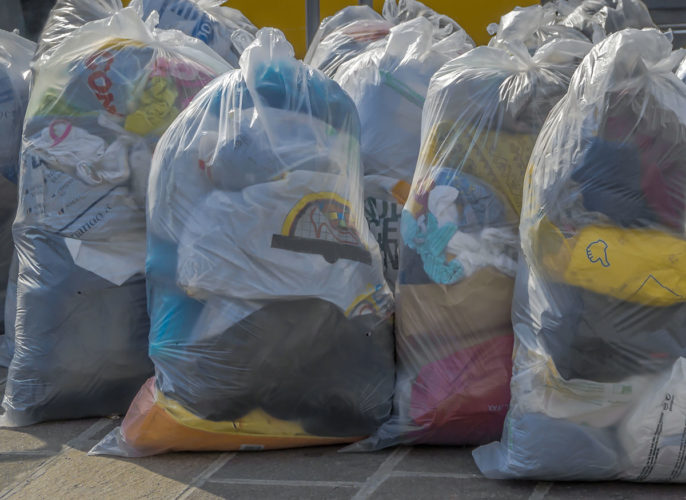Nonprofit organizations supply resources to people in need, and they’re critical for advancing the United Nation’s Sustainable Development Goals. Food banks, blood banks and humanitarian relief organizations all rely on donations.
But not all nonprofits want or need certain donations, especially if they don’t have space for them or the donations are in bad shape. Still, many nonprofits go ahead and take unwanted donations, and that can pose operational costs for the nonprofits or their partners downstream. The costs can be staggering: In 2018, Australian charities spent $13 million to dispose of unwanted clothing donations.
All is not lost, though. New research suggests strategies for how nonprofits can handle the issue of unwanted donations.

Olin’s Kaitlin Daniels, assistant professor of supply chain, operations and technology, wanted to understand the repercussions of rejecting donations. Since donors’ behavior after a rejection is not well understood, nonprofits’ strategies vary widely. For example, a survey of food banks found that 15% of them banned certain low-nutrition items, while nearly half had no nutritional guidelines or policies. Even among the food banks with nutritional guidelines, 40% reported uncertainty about how to handle unwanted donations.
A nonprofit, of course, can reject unwanted donations to control its inventory and to relieve itself and its partners of sorting, storage and disposal costs. But many nonprofits hesitate to reject unwanted donations for fear of alienating donors who might otherwise contribute helpful donations in the future. The consequences are real: Blood donors whose donations were rejected were found to be 29% less likely to donate again within 4.25 years than donors whose blood was accepted.
Daniels studied how donors respond to rejection—and how nonprofits could minimize repercussions afterward. What should organizations do with unwanted donations? “To even begin to answer that question, you need to know how the donors will respond to being turned away,” Daniels said.
Donors’ responses to rejection
In their research, Daniels and coauthor León Valdés at the University of Pittsburgh were, to the best of their knowledge, the first to conduct a controlled laboratory experiment to study donors’ responses to rejection and also the first to find evidence of donors’ self-serving bias, which refers to the tendency to conflate what is fair with what benefits oneself.
Subjects participated in a repeated game in which they decided whether to perform a real-time typing task that could generate a donation to a nonprofit of their choice.
Daniels and Valdés called this version of the experiment the “donation condition.” The subjects had to repeatedly choose whether to complete the typing task that generated a donation, which was then rejected with a probability that was unknown to the subjects.
Daniels and Valdés measured the subjects’ decisions, and they measured the subjects’ beliefs about the probability that their future donations would be accepted.
They then compared those measures against a for-profit experiment: In that, the subjects themselves received a payment generated by a task. The coauthors called this part of the experiment the “reward condition.”
Their work offers two main results.
First, they pinpointed something important about donors’ decision-making: After rejection, they were less optimistic about their chances of successfully donating again, causing their number of instances of completing the typing task (hence, donations) to fall.
Second, they identify that donors are actually biased in a self-serving way: When a lot of effort was required of them to make a donation, their beliefs about if they would be successful were more negative after their efforts were rejected in the donation condition than they were in the reward condition, the authors write in “Trying and Failing: Biases in Donor Aversion to Rejection,” published in Production and Operations Management.
This result uncovers an obstacle to managing inventory that is particularly acute, and it affirms the tension nonprofits feel, Daniels said: “Rejecting donors can negatively impact future donations, especially since a rejected donation can be used in a biased manner to excuse failure to donate in the future.”
Steps nonprofits can take
This finding is of practical use to nonprofit organizations, “serving as both a caution and a guide,” Daniels said.
“On the one hand, NPOs [nonprofit organizations] are particularly vulnerable to backlash over rejections. On the other hand, our results highlight a source of this backlash, which offers NPOs an opportunity to design their processes to try to mitigate it.”
The authors propose two concrete steps nonprofits can take:
- Reduce the effort required to make a donation. This can increase overall donations and reduce donors’ self-serving bias, Daniels said.
- Use interventions the researchers designed to dispel negative feelings. “We show that offering rejected donors the opportunity to make a small monetary contribution mitigates biased response to rejection,” Daniels said. Nonprofits may achieve similar results by offering other alternatives such as joining the nonprofit’s mailing list or supporting the nonprofit on social media.
Daniels became interested in the topic of rejected donations during an earlier conversation with Valdés about blood donations after the September 11, 2001, terrorist attacks. The surge in blood donations after the attacks helped replenish the nation’s blood supply. But blood bank officials also had a problem on their hands.
Said Daniels: “The upshot of this outpouring of generosity was that the national network of blood supply was replenished, but really there was way more blood than was needed and almost a fifth of donations were discarded.”
Daniels hopes that their behavioral study of donors’ response to rejection can contribute to further research in this area. Understanding, and mitigating, how donors react to information about unwanted donations can help nonprofits continue their critical contribution to the UN’s Sustainable Development Goals.
“They can provide goods that are actually needed by recipients, and at the same time ensure that waste is truly reduced—not transferred to downstream partners in the donations’ supply chain.”





 “There seems to be a very basic automatic preference for beauty,” Cryder said. In one study, a significantly greater percentage of participants chose to sponsor a giraffe or zebra (both rated as highly beautiful) rather than a penguin or orangutan (rated as less beautiful), despite correctly perceiving the latter two animals as more severely endangered. “If you’re asking people to make quick decisions based on intuition, then a preference for beautiful recipients emerges. However, visual judgments of neediness and beauty are negatively correlated, which means when donors are choosing the beautiful recipients, they are overlooking the needy ones, who are the ones they say they should give to.”
“There seems to be a very basic automatic preference for beauty,” Cryder said. In one study, a significantly greater percentage of participants chose to sponsor a giraffe or zebra (both rated as highly beautiful) rather than a penguin or orangutan (rated as less beautiful), despite correctly perceiving the latter two animals as more severely endangered. “If you’re asking people to make quick decisions based on intuition, then a preference for beautiful recipients emerges. However, visual judgments of neediness and beauty are negatively correlated, which means when donors are choosing the beautiful recipients, they are overlooking the needy ones, who are the ones they say they should give to.”
